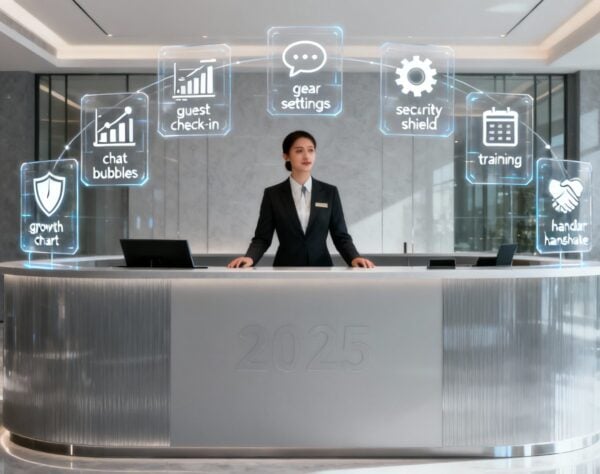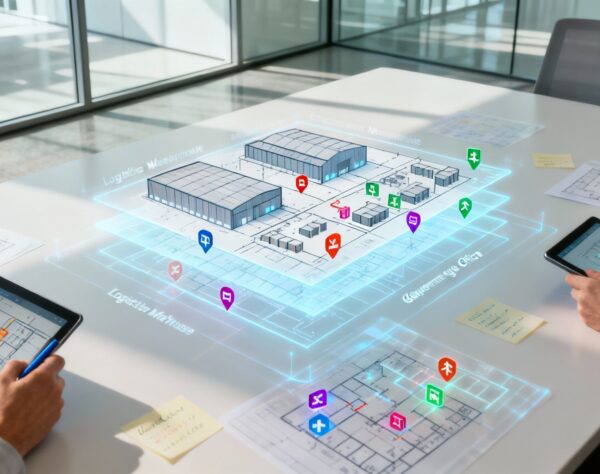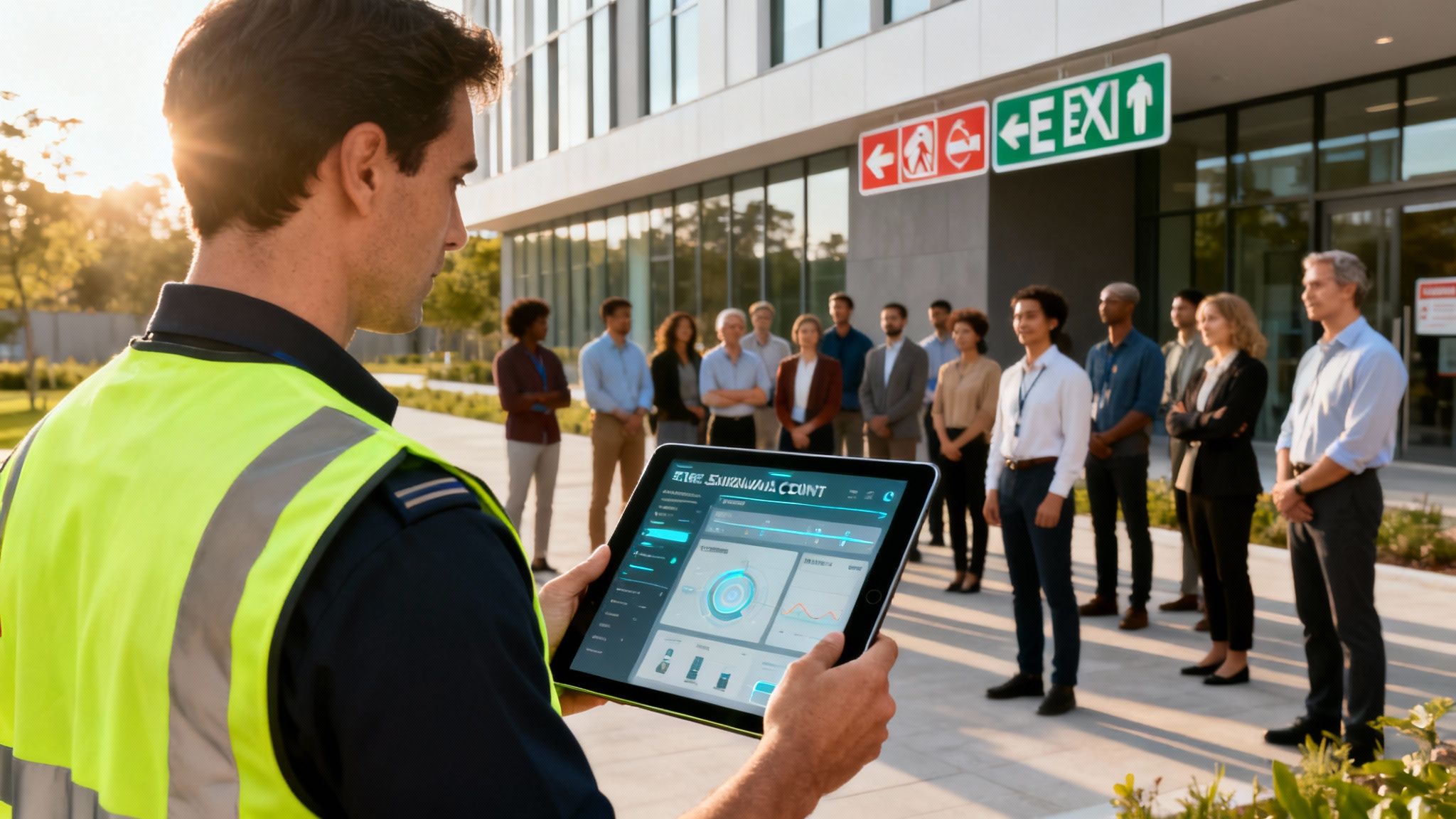
Build a Modern Evacuation Training Plan
An effective evacuation training plan is a critical safety protocol designed to guide everyone out of a dangerous situation calmly and quickly. This goes beyond a simple fire drill, covering procedures for all emergencies and ensuring every single person—from employees to visitors—is accounted for.
Why Old Evacuation Plans No Longer Work
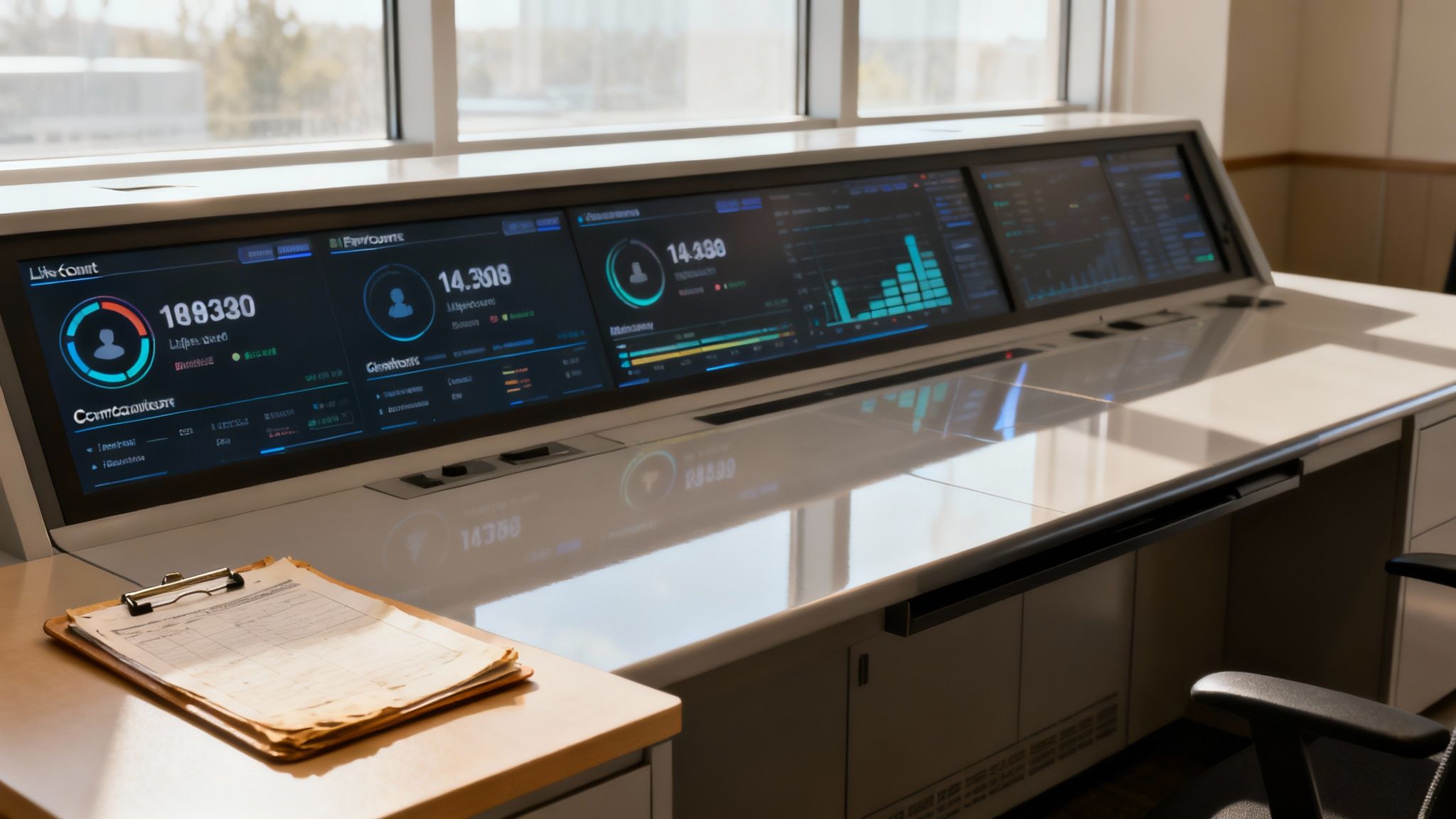
The traditional clipboard-and-whistle approach to evacuations is dangerously outdated. In a real emergency, panic can overwhelm manual processes in seconds. A paper sign-in sheet becomes a critical point of failure when every second counts, leaving you with the uncertainty of a missing visitor log or an inaccurate headcount.
Your people are your most valuable asset, and their safety is fundamental to business continuity. Sticking with old methods suggests that safety protocols are an afterthought, not a priority.
The Problem with Paper-Based Systems
The biggest flaw in outdated plans is the lack of real-time information. A paper log at reception is useless if a fire warden cannot safely retrieve it. These manual systems provide no way to instantly see who is on-site, especially visitors and contractors unfamiliar with your building’s layout.
A modern visitor management system offers the immediate, life-saving benefit of a live roll call. This gives safety officers a complete and accurate list of everyone on-site, accessible from any device. What was once a frantic search becomes a confident, organized response. You can learn how to move away from sign-in books with a visitor sign-in app and upgrade your safety procedures.
In an emergency, knowing exactly who you need to account for is the difference between a close call and a tragedy. An accurate, real-time headcount is the foundation of a modern evacuation training plan.
Meeting Modern Safety Standards
Compliance requirements are becoming stricter. For instance, recent Australian regulatory reforms for fire protection systems have increased documentation requirements, making outdated plans insufficient. These changes reflect a better understanding of real-world emergencies.
There's also a crucial shift towards more inclusive planning. National statistics show that around 18% of Australians live with a disability, highlighting why tailored support is critical during an emergency. The latest guidelines emphasize inclusive planning to assist vulnerable groups who face disproportionate risks during an evacuation. A modern plan demonstrates that their well-being is your top priority.
Designing a Plan for Real-World Scenarios
An effective evacuation plan is built for chaos, not just theory. Paper-based plans often fail under pressure because they can't adapt to unexpected events, like a primary exit being blocked. The goal is to create a dynamic, resilient strategy that works when it matters most.
This starts with a thorough hazard assessment for your specific location. Whether you face risks from fires, floods, or chemical spills, each scenario demands a unique response. A fire evacuation requires getting out quickly, while a chemical spill might demand sheltering in place first.
Mapping for Every Contingency
After assessing risks, map out primary and secondary evacuation routes. Your primary route is the quickest path to safety, but backups are crucial. Research shows that panic is a major threat during an emergency, and a blocked exit can turn a bad situation catastrophic if people don't know where else to go.
Posting route diagrams is a good first step, but a modern visitor management system provides the benefit of instant, clear communication. Instead of relying on static maps, you can send notifications with real-time route guidance directly to everyone's mobile phone, ensuring clarity in a crisis. This is a key part of a robust strategy; for more guidance, review a sample of an emergency evacuation plan to see how these components fit together.
The infographic below shows the core process for designing a plan that withstands real-world pressures.
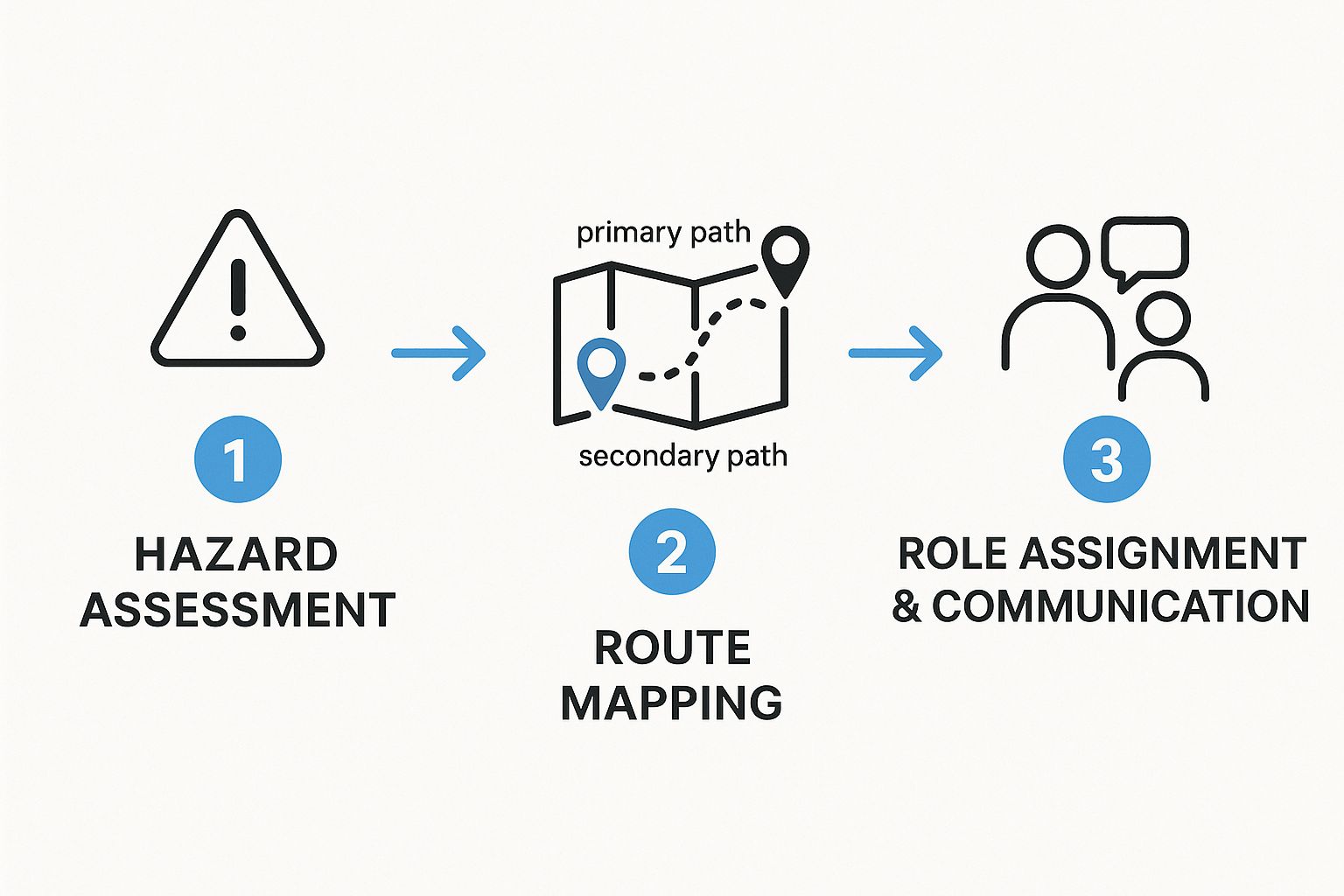
A strong plan is built on proactive assessment, clear mapping, and robust communication.
Clarifying Roles and Communication
Confusion over roles is a major point of failure in an emergency. A modern evacuation plan removes this ambiguity. A centralized digital system offers a massive advantage, allowing you to assign and communicate roles instantly.
Instead of searching for a checklist, fire wardens receive specific duties on their phones. They know which areas to sweep, who to assist, and how to report back, ensuring a coordinated response.
This brings us to clear communication. A study by the U.S. Fire Administration found that fires in nonresidential buildings caused $3.3 billion in losses in a single year, with panic often worsening the damage.
Compare outdated methods with modern solutions:
Traditional vs Modern Evacuation Plan Components
| Component | Traditional Method (The Problem) | Modern Solution (The Benefit) |
|---|---|---|
| Route Planning | Static, printed maps that can become obsolete or inaccessible. | Dynamic, digital maps sent to mobile devices with real-time updates on blockages. |
| Role Assignment | Paper checklists and verbal instructions that get lost in the noise. | Instant, targeted notifications sent directly to fire wardens and safety personnel. |
| Communication | Loud alarms and shouting, leading to panic and confusion. | Mass SMS/email alerts with clear instructions and two-way communication channels. |
| Accountability | Manual headcounts at assembly points, which are slow and often inaccurate. | Real-time, digital roll calls with status updates from individuals' phones. |
| Visitor Tracking | Illegible paper sign-in sheets, making it impossible to account for guests. | A digital visitor log that instantly identifies all non-employees on-site. |
This table highlights the gaps in older systems and how a digital approach directly addresses them. A modern system prevents chaos by giving you the ability to:
- Send Mass Notifications: Instantly alert everyone on-site—employees, visitors, and contractors—via SMS and email.
- Provide Real-Time Updates: Share ongoing information about the emergency, safe routes, and instructions from emergency services.
- Enable Two-Way Communication: Allow individuals to signal they are safe or need assistance, giving safety teams immediate visibility.
This level of communication provides reassurance and direction, drastically reducing panic and ensuring an orderly evacuation. It transforms your plan from a static document into a live, responsive safety tool.
Running Drills That Actually Prepare People
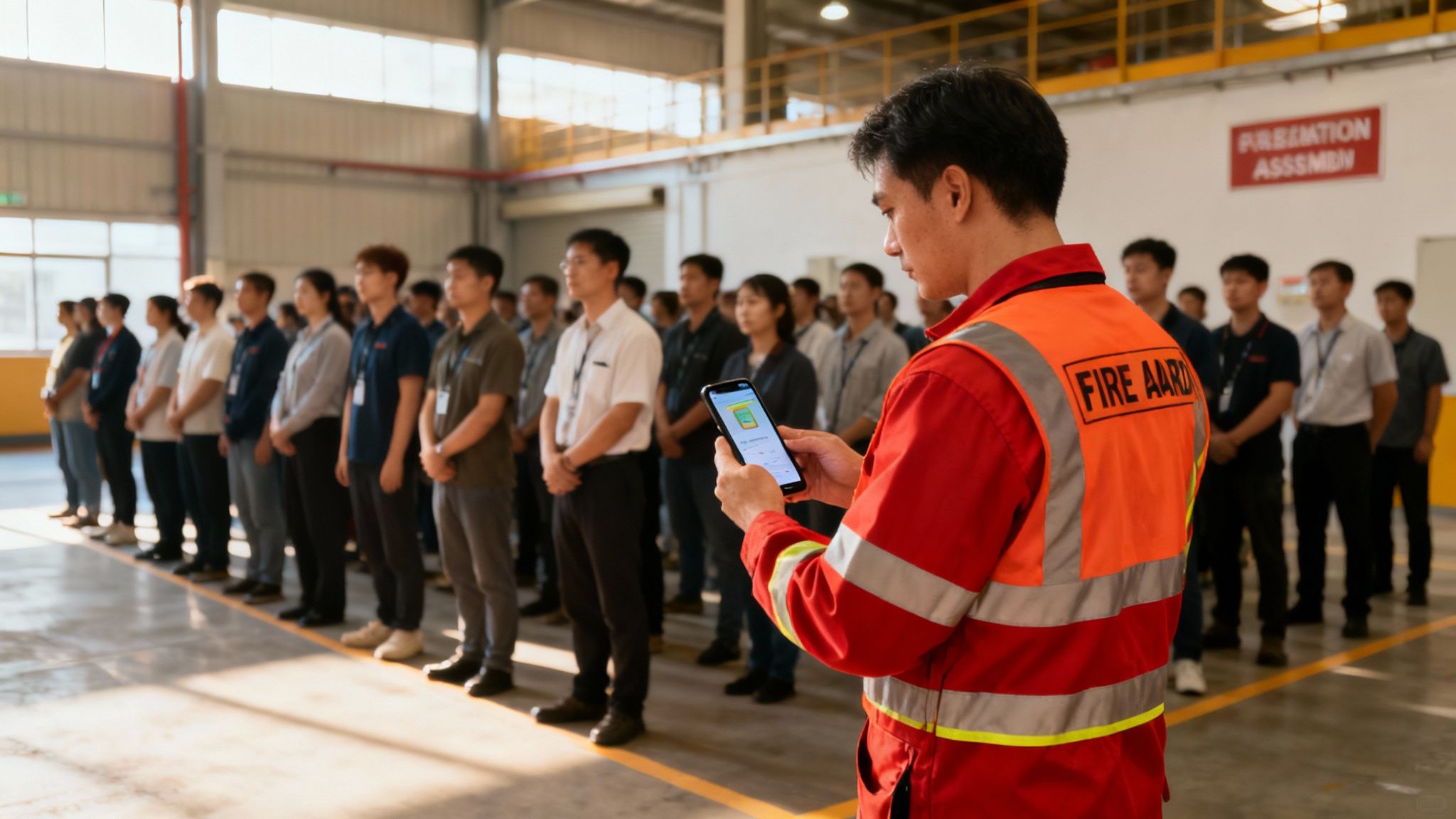
An untested evacuation plan is not a practical, life-saving tool. To truly prepare your people, you must build confidence through regular drills that simulate the pressure of a real emergency. This is where your planning gets put to the test.
Effective training involves running varied scenarios that challenge your plan. This helps people think on their feet instead of blindly following the same route every time.
From Theory to Practice
Announce the first few drills so people can learn the process without stress. Once your team is familiar, introduce unannounced drills to see how they react and uncover weak spots in your plan.
Mix up your exercises to keep everyone sharp:
- Tabletop Exercises: Gather your safety team to talk through a hypothetical emergency. This is a great way to find gaps in your communication and decision-making processes.
- Walk-through Drills: Walk the primary and secondary escape routes with your team. This simple exercise helps everyone, especially new staff and visitors, become familiar with assembly points.
- Full-Scale Simulations: Conduct a complete building evacuation. To make it more realistic, block a primary exit to test how adaptable people are under pressure.
The Power of Data-Driven Drills
A modern system transforms drills into an orderly, efficient, and data-driven exercise. Forget the chaos of wardens with clipboards trying to conduct a headcount.
With a mobile app, fire wardens perform a live roll call from their device, checking off individuals as they arrive safely. This provides an instant, real-time picture of who is accounted for and who might still be inside, allowing first responders to focus their efforts where they are needed most.
This technology is not just faster; it's more accurate. It eliminates the guesswork of manual headcounts and turns a routine drill into a source of valuable performance data. This focus on readiness is a global priority. In the African Union (AU), where over 50 million Africans are affected by natural hazards each year, disaster preparedness is a major focus. The use of early warning systems has been shown to improve evacuation times by up to 20%.
After every drill, a debrief is essential. Gather feedback from everyone involved. Combining this qualitative feedback with hard data from your system creates a powerful cycle of continuous improvement. You can easily spot bottlenecks, communication failures, and areas needing more training. Analysis is straightforward when you can view evacuation reports that deliver clear, actionable insights to refine your plan.
Achieving Real-Time Accountability in an Emergency
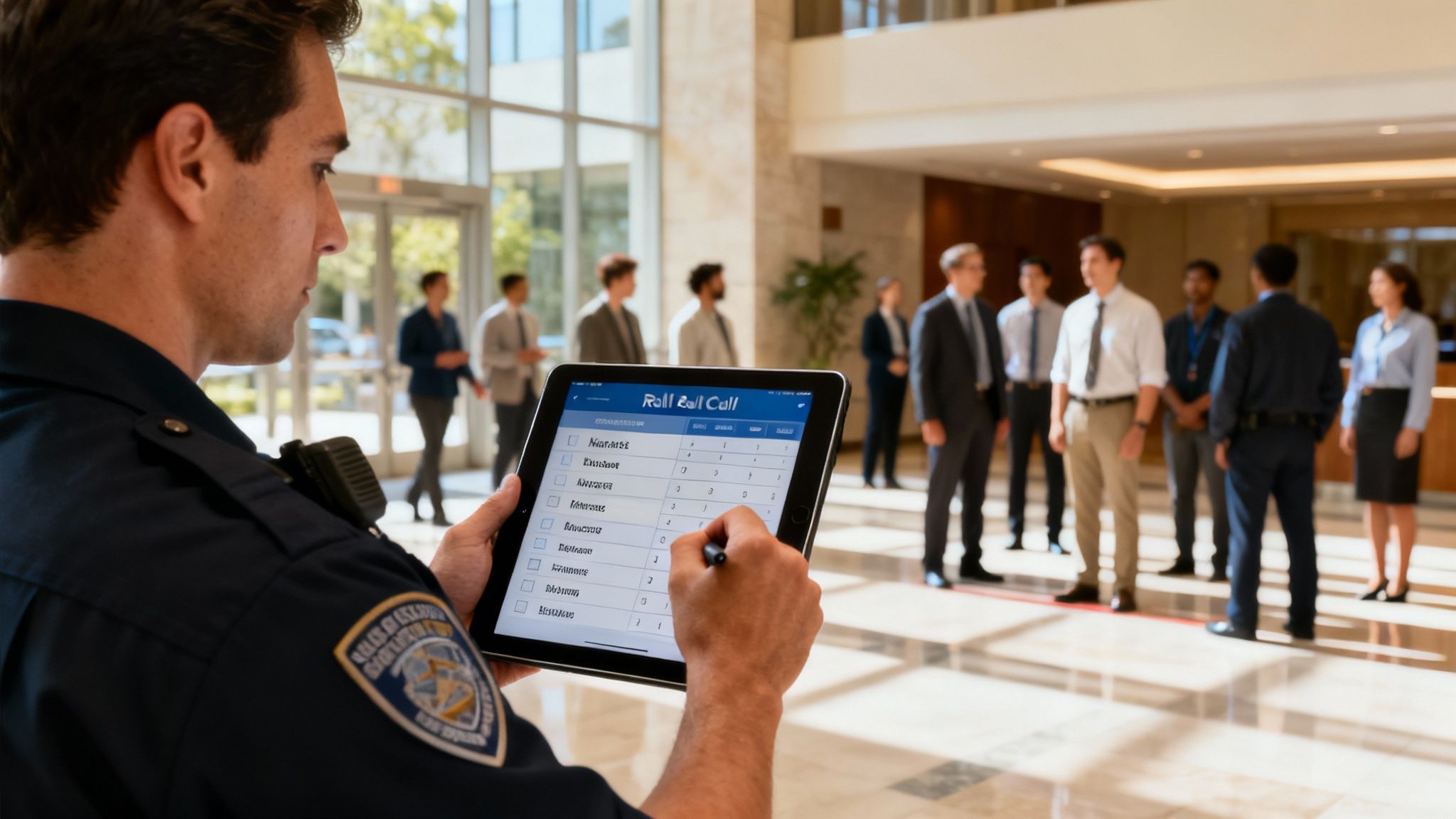
When an alarm sounds, the only question that matters is: is everyone safe? This is where a modern system proves its worth with real-time accountability. The chaos of an emergency is the worst time to search for a paper visitor log, which may be inaccessible, illegible, or destroyed.
That old method wastes precious minutes and leaves first responders with incomplete information. Research shows that panic is a major secondary threat in a fire, often making a dangerous situation worse. A clear, accurate headcount is the only way to cut through that confusion.
The Power of a Live Roll Call
A cloud-based visitor management system changes the game. Safety officers and fire wardens get instant access to a live roll call on any device. This is a dynamic, up-to-the-second register of every person on your site.
This includes:
- All Employees: No guesswork about who was working remotely or off-site.
- Every Visitor: You’ll know the name of every guest who signed in.
- Contractors and Deliveries: Every third-party individual is accounted for.
As people arrive at the muster point, wardens check them off the list instantly. This powerful benefit lets your team see in real-time who is safe and who might still be inside.
This isn't just about efficiency; it's about saving lives. Handing emergency services an accurate list of unaccounted-for people dramatically shortens their search times, allowing them to focus efforts where they are needed most.
From Headcount to Two-Way Communication
Modern systems also provide a crucial two-way communication channel. People can confirm their status directly from their own phones. For instance, you can learn how to enable an "I am safe" SMS feature that gives your team a quick way to report their well-being.
This digital confirmation provides immediate reassurance and helps your safety team quickly pinpoint who might be in trouble.
Of course, accountability during an incident is built on a solid foundation of overall safety planning. This includes understanding principles from areas like mastering risk management in construction projects, which greatly influences emergency preparedness.
By moving from a manual, reactive process to a digital, proactive one, you turn your evacuation plan into a genuine life-saving instrument.
Using Data to Continuously Improve Your Plan
A great evacuation training plan is a living process that must evolve. After a drill, the most important work begins: digging into what happened to make your people safer next time. Without concrete data, this process is just guesswork.
A modern system like VisitUs offers automated, data-rich reporting. Forget piecing together scribbled notes and manual timings. Instead, you get detailed post-drill reports generated instantly. These reports are the foundation for real, objective improvement.
Turning Insights into Actionable Improvements
Automated reports provide clear, unbiased insights into your drill’s performance. They answer the critical questions that drive meaningful change. Instead of feeling like the evacuation was slow, you can see the exact evacuation time and compare it against targets.
A data-driven approach transforms subjective debriefs into an objective strategy for improvement. It moves you from "I think we did okay" to "We know exactly where we need to get better."
This level of detail helps you pinpoint specific weaknesses. The data might show one department took 25% longer to evacuate, revealing a bottleneck that needs attention. Or it could highlight that visitor accountability took too long, showing a clear need for better front-desk training.
Key Metrics for Plan Optimisation
Analyzing the right data is key to strengthening your evacuation plan. A digital system provides the numbers for informed decisions. Focus on these core areas:
- Total Evacuation Time: Did you hit your target? If not, the data will show where delays occurred.
- Departmental Performance: Identify which teams evacuated quickly and which struggled to target follow-up training.
- Visitor Accountability Speed: How long did it take to confirm all non-employees were safe? This is a critical safety metric often missed by manual systems.
- Warden Response Times: Track how quickly fire wardens completed their sweeps and reported back. This helps spot communication gaps.
Regularly reviewing this data creates a powerful feedback loop. It ensures your evacuation training plan is continuously refined based on actual performance, not just assumptions. This methodical approach ensures your plan is genuinely effective at protecting every person in your building.
Common Questions About Evacuation Training Plans
Even with a well-designed strategy, questions arise when you put an evacuation training plan into action. Working through these common queries helps refine your approach and ensure your workplace is ready for the unexpected. The goal is to build confidence and clarity across your entire team.
Let's address some of the most frequent questions from safety managers and business leaders.
How Often Should We Conduct Evacuation Drills?
While local regulations set a minimum baseline, best practice suggests at least one full evacuation drill annually. However, the ideal frequency depends on your specific risks.
A site with hazardous materials or a complex layout should probably aim for quarterly drills. The key is to run them at different times and on different days to include all shifts and ensure every staff member gets practice. This variety builds the muscle memory needed for a calm, effective response, turning compliance into genuine preparedness.
An untested plan isn’t a plan; it’s a hope. Regular, varied drills are the only way to ensure your procedures will hold up under the pressure of a real crisis.
How Do We Account for Visitors and Contractors?
This is where traditional, paper-based systems almost always fail. A manual sign-in sheet is a recipe for disaster in an emergency—it's often illegible, incomplete, or inaccessible, making it impossible to know if a visitor is safe.
A modern visitor management system provides a game-changing benefit here. The moment a non-employee signs in, their details are logged in the cloud. During an emergency, your fire wardens get an instant, live roll call on any mobile device. They can see exactly who was on-site and check them off as safe at the muster point. This provides accurate accountability that paper logs cannot deliver, turning a chaotic headcount into a swift, organized process.
What Are the Biggest Mistakes to Avoid?
The most common—and dangerous—mistake is creating a plan but never practicing it. A plan that only exists in a binder will fail when faced with real-world panic.
Another critical error is failing to account for every person on-site, especially visitors, contractors, and temporary staff who don't know the building layout.
Other frequent missteps include:
- Vague Communication: Not having a clear, instant way to send instructions leads to chaos.
- Poorly Chosen Assembly Points: Selecting muster points that are too close to the building or in other unsafe locations.
- Undefined Roles: Failing to assign and properly train fire wardens and other key personnel.
Ready to replace your outdated clipboard with a system that provides real-time accountability and data-driven insights? See how VisitUs can transform your evacuation training plan into a life-saving tool. Learn more and book a demo today at visit-us.com.



